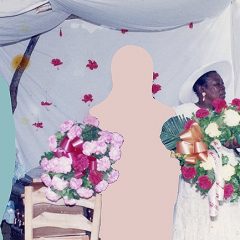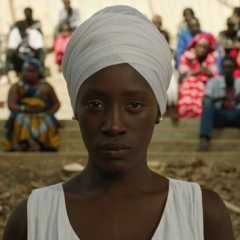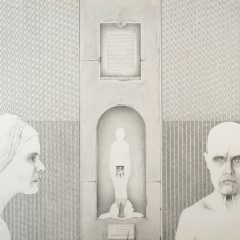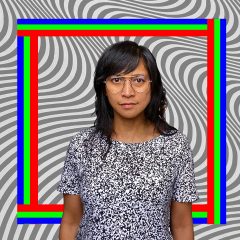–In her review of the new show at the Michener, Jennifer talks about the iconography and shifting, multi-faceted identity of America and Americans.–the Artblog editors————————
Images of a Chicana woman and a wheelchair-bound grandmother hang on the gallery walls adjacent to a young, white Rockabilly family. Nearby, Doris Bittar’s oil on linen, Camo-Flag 1 marries stars and stripes patterns with Islamic abstraction. Facing all of these works, from across the gallery, is the the visage of the great African-American artist, Elizabeth Catlett-Mora.
Infinite Mirror: Images of American Identity, currently on view at the Michener Art Museum in Doylestown, is an exhibition of great multiplicity that asks one important question: what does “America” look like?
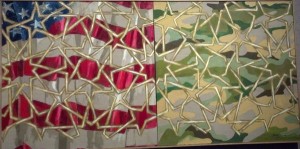
Asking this question in our “melting-pot” country naturally leads to abundant possibilities. The delight of this exhibition is that diversity is represented in the subject matter of the artwork, in the artist’s identities, and in geography.
The many Chicano, Chicana, and Native American contemporary artists in Infinite Mirror aren’t typically seen in places like Doylestown, a locus for Pennsylvania Impressionism. They may be more well-known in Texas or New Mexico.
But other artists, such as Paul Keene, are regulars; Keene’s work was featured in a solo show at the Michener in 2005. Brian Peterson, Gerry and Marguerite Lenfest Chief Curator at the Michener, explained in an email the importance of both local and national artists in this show. He noted, “…our focus is often on the art of our community…but equally important to our mission is our role as the principal vehicle for educating our community about the visual arts in general. This show fits in perfectly with that mission….”
So how did this culturally- and geographically-diverse show arrive at the Michener?
In 2006, Blake Bradford, the Bernard C. Watson Director of Education at the Barnes Foundation, curated Infinite Mirror for the group Artrain Bradford worked with two co-curators: Benito Huerta, of the University of Texas at Arlington, and Robert Lee, director and curator at Asian American Arts Centre in New York. Together they looked for regional art scenes and ethnicities to include, ensuring that the multiculturalism of this exhibition represents, as Bradford described in a phone conversation, “diversity with much greater dimension.” The exhibit has been touring the country since 2006.
Works by 39 artists are organized into four sections – Protest, Self-Selection, Assimilation, Pride – and curators at each of the museum host sites (like the Michener) decide which works to include in these categories. Some category placements at the Michener seem curious, such as placing the now-classic 1999 video, a small world… by Jennifer Zackin and Sanford Biggers, in the Protest section. This video, shown in the legendary Freestyle exhibition at the Studio Museum in Harlem in 2001 and in the 2002 Whitney Biennial, is an effective and moving work about how shared “American” experiences are a result of class. It pairs childhood home movies from both artists (one black, one white) in which we see similar birthday celebrations, trips to Disney World, and piano lessons. The work reveals the similarities of the lives of two middle class kids growing up in the 1970s and it seems to be far more about class identity than protest.
But as Bradford convincingly explains, one of the important factors for this touring exhibition about American identity is that it reveals how concepts such as pride or protest can vary in different parts of the country.
“Sometimes just existing is a form of protest,” notes Bradford, who describes Infinite Mirror as “an invitation for other people to talk about what these things might mean for them…what diversity and identity means in South Florida is very different from what identity means in New Hampshire.”

From protest to immigrant identities
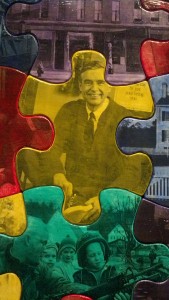
Many works of art in this exhibition successfully invite this dialogue, and Sungho Choi’s Model for My America is a summation of this idea. This large, mixed media work is a map of the US made with puzzle pieces, each printed with imagery varying from Guess jeans advertisements to Mr. Rogers to Act Up protests. For the puzzle pieces, Choi chose imagery that is, for the most part, recognizable. His America is made with uniquely American scenes and histories. In what would be the southwest is a Dorthea Lange photograph of a grocery store in San Francisco with a sign on the façade that reads: I am an American. The photo evinces the scrutiny endured by Japanese Americans after Pearl Harbor. Other famous images appear such as Timothy O’Sullivan’s portrait of five generations of an enslaved African American family in Beauford, South Carolina.
On the one hand, this map celebrates how our unique shapes fit properly together. But the work also confirms how being part of this complex puzzle means that some people have privileges that others do not. It asks us to contemplate the devastating parts of a perfect union.
Assimilation and absurd stereotypes
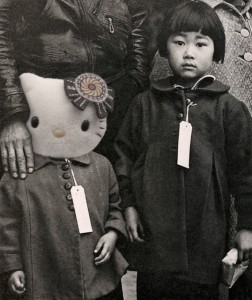
Appropriated photographs by Dorthea Lange also show up in the work of Scott Tsuchitani. His digital print of two young children, one with a Hello Kitty head, uses Lange’s photograph of the Mochida family which became part of the propaganda of the Second World War. Included in the Assimilation section, this print weaves past events with more current assimilations of culture. The Hello Kitty reference may suggest another version of an imprisoning stereotype with which Japanese Americans contend. With humor, the artist makes uncanny associations that expose the absurdity of stereotypes.

Pride
So many works in this exhibition exude pride. In some, such as Delilah Montoya’s large photograph of Elisabeth “Pink Panther” Monge, Farmington, NM we get to share in the feeling of strength, determination, and power of this young, Chicana, female boxer. Jennifer Greenburg’s photographs of Rockabillies are equally commanding. The images reveal how identity is so often created through clothing, cars, hairstyles, and even pink plastic flamingoes, and how attributes such as these are markers of meaningful community. Of course, we are all a part of the community created by this exhibition. And after walking around the galleries for a while, one might begin to wonder about their own shiny reflection in the infinite mirror.

Infinite Mirror: Images of American Identity is on view at the James A. Michener Art Museum in Doylestown, PA through July 7, 2013.


